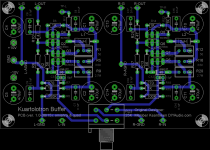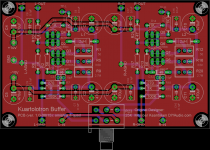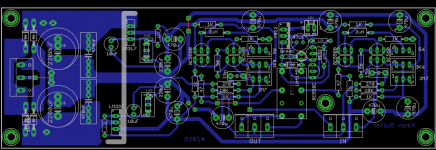Nice, you should give the volume control an upgrade to really show it off!
Thanks, Destroyer. Already ordered!
Thanks, Destroyer. Already ordered!
Keantoken said his was a nice step up in clarity, and didn't cause sibilance like a Dale resistor unit from eBay.
What are those orange caps you're using?
Where is the volume potentiometer connected, before or after the buffer?The caps are Keltron, an old Indian brand. Around here, it's safest to buy Keltron as there are too many fakes of the big capacitor brands.
Hi just some tips to make your PCB more useable. It would be nice if wiring would be brought back to a minimum. Inputs could be routed to the back of the board where the RCA connectors will be. Also extra pads for Alps RK27 would be nice in case you want to use such a potentiometer when the buffer stays in your system. Adding a simple but well filtered PSU and input switching with relays would make it complete. Just connect a 2 x 9V transformer and switch it on. Why a separate PSU board with extra wiring and connectors and extra costs when you can add it to the existing PCB design ? You can use 7810 + 7910 or LM317 + LM337 with extra filtering but the PSU of the DCB1 comes to mind....Since regulator ICs are cheap you could use regulators for each channel. Personally I would use more recent SMD low noise LDO regulator chips but those are more expensive than the oldies.
BTW I think you have to add input and output film caps to avoid power amps blowing up. A mini relay with delay shorting the output to GND during power on sequence (to avoid power on thumps) is also a necessity if you like your woofers. This protection relay can only be used when output caps will be used ! Please add pads for standard MKDSN Phoenix connectors as soldering wires to a PCB is not common practice as PCBs will be damaged. Since I made several DCB1/Mezmerize buffers I thought of designing a PCB of this buffer with the same footprint as Mezmerize just to be able to exchange boards. IMHO this Kuartlotron (it is misspelled on your PCB) needs the same added circuitry for use in real life Designs should be simple but not too simple.
Designs should be simple but not too simple.
BTW I think you have to add input and output film caps to avoid power amps blowing up. A mini relay with delay shorting the output to GND during power on sequence (to avoid power on thumps) is also a necessity if you like your woofers. This protection relay can only be used when output caps will be used ! Please add pads for standard MKDSN Phoenix connectors as soldering wires to a PCB is not common practice as PCBs will be damaged. Since I made several DCB1/Mezmerize buffers I thought of designing a PCB of this buffer with the same footprint as Mezmerize just to be able to exchange boards. IMHO this Kuartlotron (it is misspelled on your PCB) needs the same added circuitry for use in real life
Last edited:
There is no need for chipregs or expensive LDO regulators when a single TL431 will do, as I showed earlier.
Circuits can behave badly before they are fully turned on. Generally people advise you not to turn on a preamp or buffer while the power amplifier is on for this reason. I can't guarantee that the Kuartlotron will turn on smoothly, although I haven't heard of anyone having problems with this so far.
I can show some changes to the circuit which will probably make it turn on with just a snap if anything.
That said I don't think that as it is, the Kuartlotron can emit a poweron thump significantly more powerful than what the musical recording is capable of.
Circuits can behave badly before they are fully turned on. Generally people advise you not to turn on a preamp or buffer while the power amplifier is on for this reason. I can't guarantee that the Kuartlotron will turn on smoothly, although I haven't heard of anyone having problems with this so far.
I can show some changes to the circuit which will probably make it turn on with just a snap if anything.
That said I don't think that as it is, the Kuartlotron can emit a poweron thump significantly more powerful than what the musical recording is capable of.
Call me old fashioned but making it impossible to occur would be a good step for all possible users and scenarios. DC blocking caps and a muting relay eliminate some failure possibilities with costly outcome. If the builder does not want caps jumper wire can be used. Adding the pads on the PCB costs nothing. I know the adagio to switch on preamp/buffer first but let's be honest: mistakes do occur and some family members just don't know or care. IMO it is plain good design practice to mute outputs at power on/off. Costs are minimal certainly compared to the costs of burned woofers. Added bonus is that no power on thump is heard. Power on/off muting is IMO a must and especially so with DC coupled gear. Even when the power on/off behavior is good only the removal of thumps would be enough for me to justify using a muting relay. BTW more than once I have experienced servos of DC coupled gear to interact with each other. My solution was to break the loop between buffer and power amp also for protection against DC when one of the devices in the chain would break down. It saves the speakers and possibly the power amp. Sometimes capacitors are valuable friends....
Using good to excellent supplies won't break the bank and the design won't go bad with good/excellent power supplies. It is not a frugal design is it ? Almost any DIY device will cost more than ready built stuff anyway and this whilst ready made stuff has muting relays, DC blocking caps and regulators There is no need to build a buffer with basic features lacking, it should be complete and easy to replicate for builders with common annoyances and possible risks reduced to a minimum. We are not talking about bling bling or tons of flashing LEDs and "features".
There is no need to build a buffer with basic features lacking, it should be complete and easy to replicate for builders with common annoyances and possible risks reduced to a minimum. We are not talking about bling bling or tons of flashing LEDs and "features".
OK, I must add this: it screams for a one board PCB design (you just knew I was going to write that)
Using good to excellent supplies won't break the bank and the design won't go bad with good/excellent power supplies. It is not a frugal design is it ? Almost any DIY device will cost more than ready built stuff anyway and this whilst ready made stuff has muting relays, DC blocking caps and regulators
OK, I must add this: it screams for a one board PCB design (you just knew I was going to write that)
Last edited:
This already smells like Group Buy PCBs (if Keantoken is OK with that)....Just compare to Mesmerize, PCBs for that one are still being sold. No one wants various PCB's and excess wiring etc. anymore. Just have a look at your drawer with unfinished projects and check to see WHY they aren't finished. The world would be a lot better place with single board designs  Now throw your hands up in the air and stamp your feet yelling : "Single board ! Single board ! Single board !" You will notice a relaxing feeling of peace and quiet and your thinking won't be hampered by wires coming from all directions. Just give it a try and convert now before it is too late !
Now throw your hands up in the air and stamp your feet yelling : "Single board ! Single board ! Single board !" You will notice a relaxing feeling of peace and quiet and your thinking won't be hampered by wires coming from all directions. Just give it a try and convert now before it is too late !
A design is only mature when it is out of the concept stage, then comes the time stealing stage of making it a practical workable and good performing system that can be used in everyday life. Otherwise it will be just some JPEGs of breadboards in history. This design is way too nice for that.
A design is only mature when it is out of the concept stage, then comes the time stealing stage of making it a practical workable and good performing system that can be used in everyday life. Otherwise it will be just some JPEGs of breadboards in history. This design is way too nice for that.
Last edited:
Well I haven't finished my PCBs but I will keep trying, so I can benefit from this some way if possible. I'm just too slow.
I can start on a Mesmerize swap, but the board has very nonstandard dimensions. I cannot know where to put the pot footprint for instance so that the volume shaft will line up with the hole on existing builds.
I can start on a Mesmerize swap, but the board has very nonstandard dimensions. I cannot know where to put the pot footprint for instance so that the volume shaft will line up with the hole on existing builds.
Although nonstandard it is now a standard itself. Keeping the same dimensions would make a swap a piece of cake for existing DCB1/Mezmerize owners (if the Kuartlotron is better of course).
No necessity though but a one board PCB design would be perfect. I can assist but I am also slow.
No necessity though but a one board PCB design would be perfect. I can assist but I am also slow.
In the case of construction error, an output relay would not protect proceeding equipment. But in the case of someone powering on the buffer at the wrong time, the Kuartlotron can be made without a dangerous turn-on thump. Unless a complex protection circuit is used, I don't think there is much benefit to using a relay at the output.
It will when it shorts output to GND fast. Delay at power on and fast switching at power off. Simple, effective, cheap and standard on 99% of buffers/preamps because it costs way less than the devices it will (rudimentarily) protect. I am quite sure that most of us that have built buffers/preamps without muting relay have experienced the smell of burned woofers. If it was not when using the thing then it was with measuring the thing  It is a once in a lifetime experience that changes decision making on the subject at once.
It is a once in a lifetime experience that changes decision making on the subject at once.
Try to think of your concept as a complete product that will be used by different people in different situations please. I once did a GB here and we sold hundreds of DAC PCBs. You would be surprised what kind of problems/challenges can arise which you likely did not take into account beforehand. So it is clever to think ahead but it is your design. If you want it to stay a concept than that is your choice. For most other people it is a building block in a device and simply can not function on its own.
Try to think of your concept as a complete product that will be used by different people in different situations please. I once did a GB here and we sold hundreds of DAC PCBs. You would be surprised what kind of problems/challenges can arise which you likely did not take into account beforehand. So it is clever to think ahead but it is your design. If you want it to stay a concept than that is your choice. For most other people it is a building block in a device and simply can not function on its own.
Last edited:
- Home
- Source & Line
- Analog Line Level
- The Kuartlotron - keantoken's simple error-correction superbuffer


